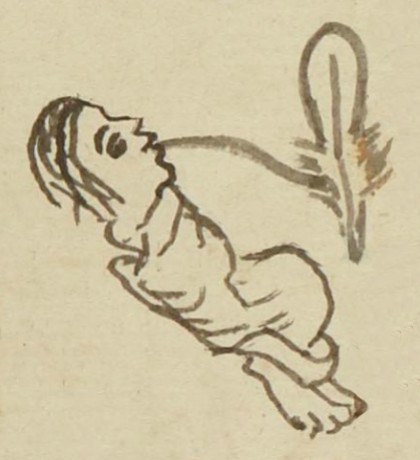Toztimal (MH560r)
This black-line drawing of the compound glyph for the personal name Toztimal (perhaps “Yellow-Pus,” attested here as a man’s name) shows a profile view of a reclining male figure wearing a cape or wrapped in a blanket. A parrot feather (tozqui) is attached to him by a line. The feather is not colored, it is upright, and it is fluffy at the bottom, which may be telltale signs that it comes from a yellow-headed parrot.
Stephanie Wood
Perhaps this person is yellow and pussy because he is sick from epidemic disease, which was prevalent in the sixteenth century. The reclining posture and being wrapped with a blanket may suggest this.
It could also be worth exploring whether bodily excretions have a significance as something of value or importance in life. Teocuitlatl (divine excrement), or gold, is highly valued. The excretions from the bumps on toads were awe-inspiring for their venom, but they were used in some rituals to bring people to a hallucinogenic state. The toad "stores a highly toxic substance to protect it from its enemies. Native shamans knew of this substance’s properties and used it to prepare a ritual dream-making drug." [This remark is published in Mexicolore and draws from Aztecs (Royal Academy of Arts exhibition catalogue, London, 2002), p. 415.] The quincunx shape to the sore here suggests that an excretion of pus might have a relationship to the cosmos. Pustules, of course, were also ominous when associated with smallpox and other epidemic diseases that swept through New Spain in the sixteenth century. Furthermore, the vivifying force of tonalli "could escape through openings in the body" (Caplan, 2020, 386), and so perhaps this sore would be a cause of great concern.
In the Historia Tolteca Chichimeca of 1598, Tezozomoc mentions a Toltec named Timal, who was known to have super necromantic powers. Oxford defines necromantic as "relating to witchcraft or black magic, especially the supposed practice of communicating with the dead." [Wimmer 2004 quoted Tezozomoc, and this is published in the Gran Diccionario Náhuatl, https://gdn.iib.unam.mx/diccionario/timal/175522.] The religious prejudice in choosing the term should not overshadow the take-away that Timal was perceived to have special religious or ritual abilities, which may enter into the glyphs for the name Timal, taken by various men of central Mexico perhaps in honor of the famous Toltec man, "Pus," who possibly used deadly excretions to help people reach a risky dream-like state.
In some vocabulary terms found in the dictionary, the element -timal- leans toward something like "full of pride" or "glorified by others." These glyphs for the name Timal deserve further study.
Stephanie Wood
pedro toztimal
Pedro Toztimal
Stephanie Wood
1560
Jeff Haskett-Wood
feathers, plumas, parrots, loros amarillos, sick person, enfermo, sores, llagas, pus, pudre, nombres de hombres

toz(tli), yellow headed parrot, https://nahuatl.wired-humanities.org/content/toztli
timal(li), pus, excretions from sores, and a man's name with a possible necromantic association, https://nahuatl.wired-humanities.org/content/timalli
Materia del Loro Amarillo
Matrícula de Huexotzinco, folio 560r, https://www.loc.gov/resource/gdcwdl.wdl_15282/?sp=199&st=image
This manuscript is hosted by the Library of Congress and the World Digital Library; used here with the Creative Commons, “Attribution-NonCommercial-ShareAlike 3.0 License” (CC-BY-NC-SAq 3.0).










